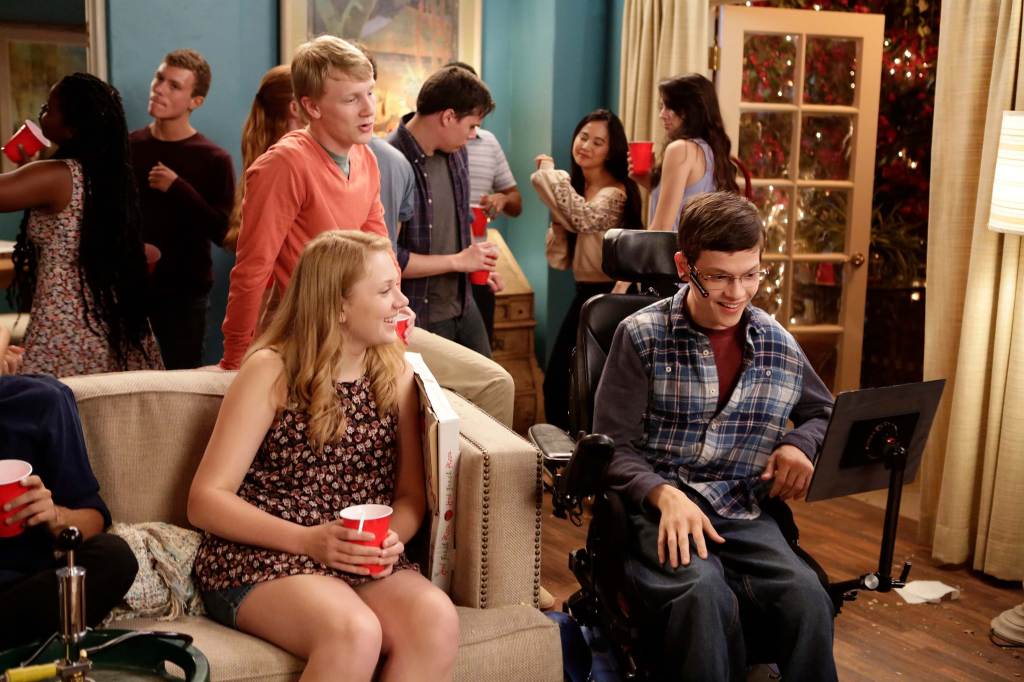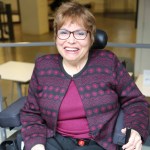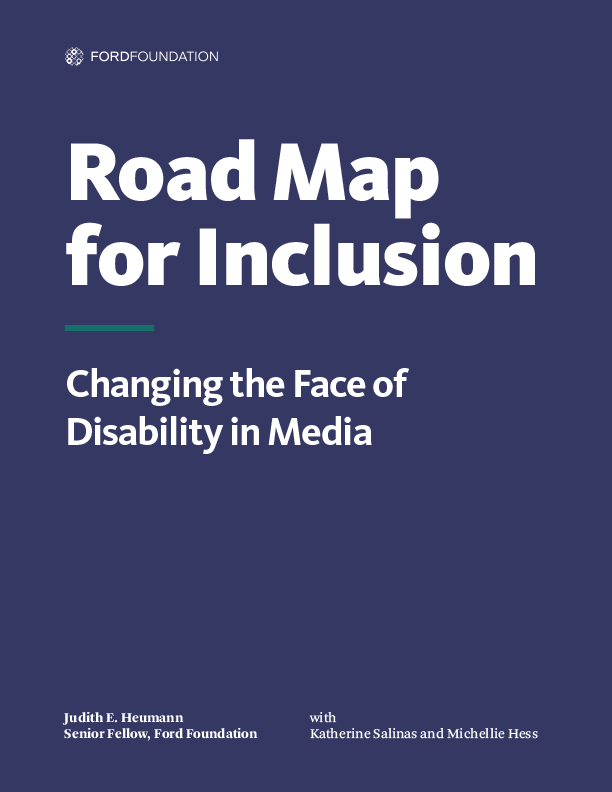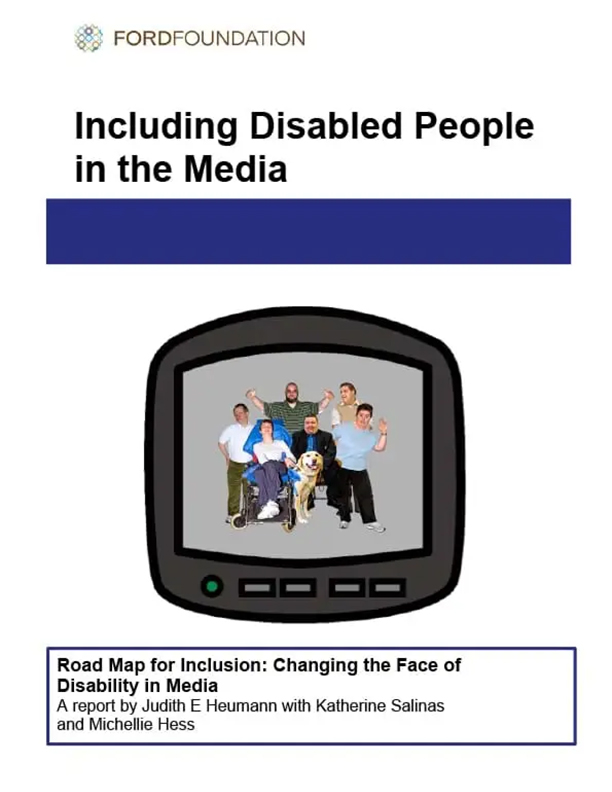
Judy Heumann is an internationally recognized disability rights leader, known especially for her work as an advocate with disabled people across different social justice movements. Since the early 1970s, when she sued the New York City Board of Education and became the school system’s first teacher who used a wheelchair, to her roles in the independent living movement, with the World Bank, and in the Obama Administration as the first special advisor for international disability rights at the US Department of State, Heumann’s efforts have been critical to the disability rights movement and other movements for justice.
In 2017, she joined the Ford Foundation for a yearlong fellowship, working with the foundation’s staff to integrate a disability-inclusive perspective across their work. On her own, she launched an exploration into the inclusion of disability in film and television (and lack thereof). At the conclusion of her fellowship and this research, we are pleased to publish the resulting report, Road Map for Inclusion: Changing the Face of Disability in Media.
Heumann offers a rigorous study of how disability has typically, and problematically, been portrayed in scripted television and film, from Sesame Street to Breaking Bad, and highlights examples of progress. She looks at how other minorities and countries have succeeded in shifting the way they are represented in the media, and how the growing disability rights field can learn from the progress they’ve made. And she offers concrete recommendations about how the media can reduce stereotypical representations of disability—and in doing so, help reduce discrimination and advance equality.
“The disability experience ought to be an intrinsic element of the media’s representation of society,” she writes. “The time has come to seriously and comprehensively take steps that will move us from the margins to the main stage.” Here, Heumann discusses her report’s essential findings, the challenges of authentic representation, and how media can be part of the solution.
Ford Foundation: Let’s unpack the root of the problem that you explore in this report. You point out that one in four Americans is disabled—clearly, that’s a lot of people. Why, then, do you think there’s such a lack of representation?
Judy Heumann: I think it’s due to many different factors. People have not looked at disability from the perspective of discrimination. And disabled people have been an amorphous group—who are we? What are our issues? How would you report on it? We are by and large invisible.
Historically we’ve looked at disability as something negative: the tragedy of disability, the portrayals of disabled people as evil characters or saintly characters. Then there’s the belief that since disability is a tragedy, the solution is to cure disabled people. The average person does not yet see the contributions of disabled people as something they’re missing, whether in books, on TV, in films, or in journalism. And there’s still a lack of discussion on this issue.
However, the disability community is demanding authentic representation and speaking out— when non-disabled people are playing roles of disabled people, or when the subject matter is limited. When you start speaking about it, you realize there are other people out there like you, and other people who have been, in the case of disability, disadvantaged.
Why is representation so meaningful?
There’s a profound lack of knowledge about who disabled people are as individuals and who we are as a group. Disability cuts across race, sexual orientation, religion etc. The issue of stigma is also quite profound. Today, frequently, there are people who will see me and not talk to me, but they’ll talk to somebody else that I’m with. Or I get the feeling that they’re not quite listening to me, not taking me seriously, because they see I have a disability.
And many people’s disabilities are not so visible: psychosocial disabilities, depression, anxiety, bipolar, cancer, lupus, multiple sclerosis, epilepsy, they are hard of hearing, and on and on. These disabilities are invisible, or people hide them for various reasons. With films like Unrest, by Jen Brea, which is about people who have hidden disabilities, more people are beginning to identify as having a disability. And as more people identify in a way that allows us to say, “I have a disability” and not be ashamed of it, it can have an impact.
That’s why media is so important: it creates dialogue. We don’t have to agree with everything that’s being presented, but when nothing is being presented, it makes it hard for people to learn about who we are—and who we’re not. It’s the same thing with any other group, whether that’s Muslims, or people of color, or immigrants or LGBT people.
I am cautiously optimistic that this paper will be able to help contribute to advancing the visibility of disability in media, not just in film and television.
As you researched this subject, did you come across anything that surprised you?
The Annenberg Inclusion Initiative states that in the 100 top grossing movies of 2016, only 2.7 percent of the characters depicted had a disability, and only 2.5 percent of characters over the past ten years have been depicted with a disability. And nearly half of the films across the top 100 did not include a single character with a disability. The Ruderman Family Foundation found that 95 percent of the characters with disabilities in the top 10 TV shows are played by non-disabled actors and that disability is the most underrepresented minority in Hollywood. That is a problem. But it doesn’t surprise me, exactly.
At the age of 70, does anything really surprise me? I think the answer is no. Although it’s been my life’s work to advocate for the rights of disabled people, I continue to be struck by the extent to which disability is still not on the agenda of organizations and companies that otherwise do care about increasing diversity and inclusion. So often, disability is left out.
Nor has it been on the agenda of donors. That, to me, is a big issue. If every foundation that funded media included disability in its work, there would be a dramatic change over the next five years. We need to help create opportunities so that disability can be seen as a relevant issue.
I appreciate that the first step has been taken by Annenberg, Ruderman, GLAAD, and others and data is now being collected; now we know how much further we have to go. The convening we held at the Ford Foundation last June brought together a diverse and dynamic group of people representing organizations like the National Minority Consortium, GLAAD, Annenberg, Sundance, PBS, BBC, Channel 4, as well as professionals from various media fields who have disabilities. There is a growing consensus that no one is satisfied with how disability is represented, either in producing authentic roles, casting, or writing, and when it comes to true inclusion in production from behind the camera to on the screen. The recommendations in this report are intended to provide the next stage for discussions on how to move the bar not only further but more rapidly. Our convening’s attendees have shown us that we have passionate partners who are eager to include disability not only in their definition of diversity but in their work across the board.
You recently wrapped up your fellowship at Ford. What did it enable you to explore or learn—or help the foundation learn?
My exposure to Ford started in the early 1980s, and it has really only been in the last couple of years that the foundation is looking at this issue. And I feel there’s a genuine sincerity on the part of staff to make progress. So one of the purposes of the fellowship was to help the foundation itself learn more about disability. I collaborated on multiple events and projects with the foundation that explored and highlighted disability rights as human rights. I also got the opportunity to interact with Ford staff and discuss their work and learned how our two worlds melded.
Ultimately this issue is only going to get the level of traction it needs if people in government, in nonprofits, in civil society, and in the philanthropy community understand its importance. There’s a richness to ensuring that as a democracy we are really reflecting the breadth of who lives in this country, and around the world.


